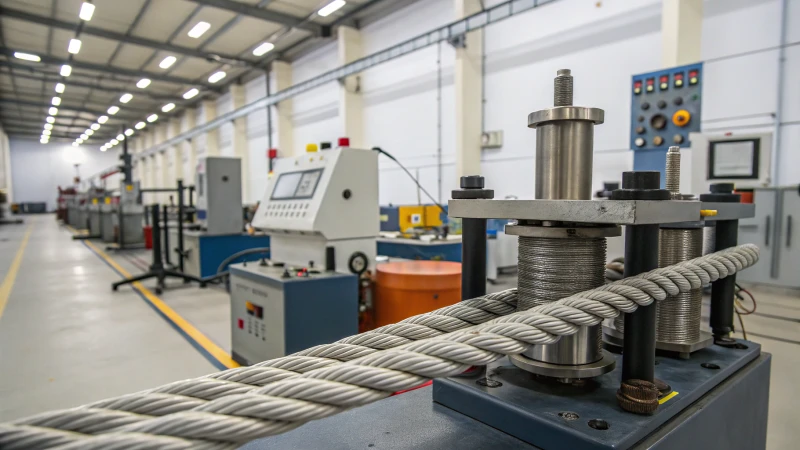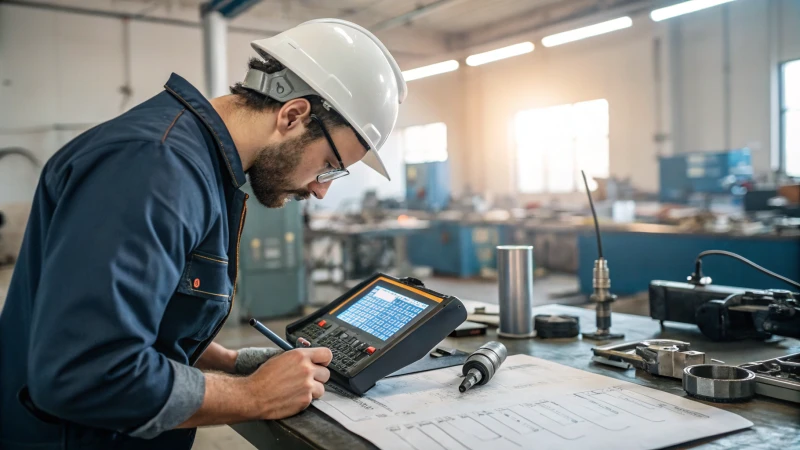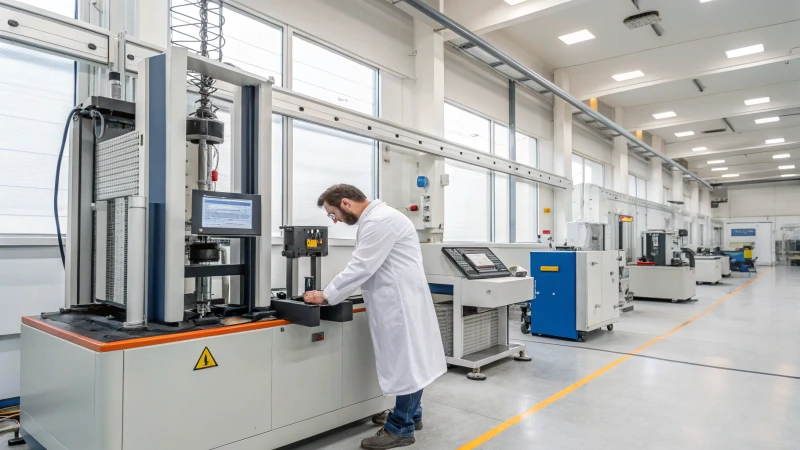
Have you ever wondered how elevator ropes manage to stay reliable day in and day out?
Testing the fatigue resistance of elevator steel wire ropes involves applying cyclic loads at different frequencies and amplitudes, in line with standards like ISO 4344 and ISO 18146. This process determines how many cycles a rope can withstand before failing, ensuring its reliability in real-world elevator systems.
I remember the first time I stood in front of a massive test rig for steel wire ropes. It was a bit intimidating, knowing these ropes are the unsung heroes of elevators, handling countless ups and downs every day. The testing process is crucial; it mimics real-world stressors through rigorous cycles to ensure each rope's durability. Understanding the intricacies of this testing process not only highlights the rope's construction but also assures me of the safety standards we adhere to. With modern techniques like magnetic particle inspection, detecting early signs of fatigue has become even more reliable, offering peace of mind that every ride is as safe as possible.
Elevator ropes are tested using ISO 4344 standards.True
ISO 4344 is a standard for testing the fatigue resistance of elevator ropes.
Fatigue tests measure rope length changes under stress.False
Fatigue tests measure cycles to failure, not length changes.
What Are the Key Standards for Fatigue Testing of Steel Wire Ropes?
Ever felt like you’re hanging on by a thread? That’s why understanding fatigue testing for steel wire ropes is crucial. It’s about ensuring these ropes can handle the pressure, just like us in our everyday lives.
Key standards for fatigue testing of steel wire ropes, such as ISO 4344, ISO 18146, and ASTM A416, outline cyclic load testing procedures to evaluate durability and performance under stress.

Understanding Fatigue Testing Standards
Remember the last time you faced a tough challenge that tested your patience and endurance? Steel wire ropes go through similar trials in their own way. Imagine them like the unsung heroes of construction and mining, constantly tested to ensure they can withstand real-world pressures. This is where fatigue testing comes into play—it's like putting these ropes through a boot camp to see how long they can hold up.
The standards that guide this rigorous process, like ISO 4344 and ISO 18146, are essentially the training manuals. They detail how to apply repeated loads at different speeds to measure a rope's breaking point. ISO 43441 provides a full rundown of testing methods, while ISO 181462 hones in on specific resistance features.
- Table: Key Standards Comparison
| Standard | Focus | Application |
|---|---|---|
| ISO 4344 | Cyclic Load Testing Methods | General Applications |
| ISO 18146 | Fatigue Resistance Parameters | Elevator & Lifting Ropes |
| ASTM A416 | Stress and Strain Criteria | Pre-stressed Concrete |
Fatigue Testing Procedures
Think of this as a workout routine for steel wire ropes. It’s like running a marathon every day—they get stressed repeatedly to simulate their real-life roles. For example, elevator ropes, which carry hundreds of people daily, must endure fatigue testing to guarantee safety and reliability. ASTM A4163 dives deep into stress guidelines, showing how ropes can withstand continuous use.
Comparing Rope Constructions
Ropes have their own "DNA," which affects their fatigue resistance. I recently learned that ropes with a 7×19 construction have about 40% better fatigue resistance than those with a 6×19 setup, especially in elevators. It's like choosing between sneakers or dress shoes for a hike—the right choice makes all the difference when it comes to durability and reliability.
Detecting Early Signs of Fatigue
Just like we keep an eye on our health to catch issues early, advanced techniques such as magnetic particle inspection4 and ultrasonic testing are used to spot damage in ropes before it becomes visible. These methods act as preventive measures, ensuring that any potential issues are addressed long before they escalate.
- Table: Detection Methods and Benefits
| Method | Benefits |
|---|---|
| Magnetic Particle Inspection | Early Damage Detection |
| Ultrasonic Testing | Identifies Internal Flaws |
Ultimately, understanding these standards isn’t just about technical specs—it’s about ensuring peace of mind, knowing that these ropes are ready to perform safely and reliably in demanding situations.
ISO 4344 focuses on cyclic load testing methods.True
ISO 4344 provides comprehensive guidelines on fatigue testing methodology.
7×19 construction ropes have worse fatigue resistance than 6×19.False
7×19 construction offers up to 40% better fatigue resistance than 6×19.
How Does Rope Construction Influence Fatigue Resistance?
Ever wondered why some ropes last longer under stress than others? It all boils down to their construction.
Rope construction affects fatigue resistance by influencing how loads are distributed and the rope's flexibility. More strands, as seen in 7×19 constructions, enhance fatigue resistance by evenly spreading the load.

Understanding Rope Construction and Its Impact
I've always been fascinated by how the simple twist of a rope can make such a big difference in its strength and durability. You know, it's not just about how thick a rope is—it's also about how it's built. The construction of a rope, which dictates how its strands are laid and intertwined, plays a huge role in its fatigue resistance. Different constructions spread stress differently, and that can really affect how long the rope lasts.
Strand Count and Configuration
I remember this one time when I was involved in a project that required some serious heavy lifting. The ropes we were using had a 7×19 construction5, and they performed beautifully under stress. Ropes with higher strand counts, like this one, tend to handle loads better. They use multiple smaller strands to spread the load more evenly, reducing those pesky stress concentrations that can lead to failure.
- 7×19 Construction: It features seven bundles of 19 wires. This structure offers impressive flexibility and fatigue resistance.
- 6×19 Construction: With six bundles of 19 wires each, these ropes are generally less flexible and more susceptible to fatigue.
| Construction Type | Strand Count | Fatigue Resistance | Flexibility |
|---|---|---|---|
| 7×19 | 133 | High | High |
| 6×19 | 114 | Moderate | Moderate |
Material Composition
Material makes a big difference too. Stainless steel ropes6, for example, often resist environmental wear better than their galvanized counterparts. This can be crucial in environments that are particularly harsh or corrosive.
Core Type
Then there's the core type—whether it's fiber or steel. I've found that while steel cores offer great support under heavy loads, they might sacrifice a bit of flexibility compared to fiber cores.
Testing and Standards
Fatigue testing is like putting these ropes through a trial by fire. Standards like ISO 4344 and ISO 18146 provide guidelines to measure a rope's endurance under cyclic loads. These tests help predict how different constructions will hold up in the real world.
Understanding these nuances can be incredibly helpful for someone like me, who needs to pick the right rope for the job—whether it's for construction, mining, or marine applications. For further insights into fatigue testing standards, explore ISO 4344 guidelines7.
Selecting the right rope means considering load requirements, environmental conditions, and operational demands, ensuring you get optimal performance and safety for any critical application.
7×19 ropes have higher fatigue resistance than 6×19 ropes.True
7×19 ropes distribute loads more evenly due to more strands.
Stainless steel ropes degrade faster than galvanized ones.False
Stainless steel resists environmental degradation better than galvanized.
How can we spot early fatigue damage effectively?
Have you ever paused to think about the tiny cracks that could derail an entire operation?
Advanced techniques for detecting early fatigue damage, such as ultrasonic testing, magnetic particle inspection, and advanced thermography, are essential for identifying micro-cracks and stress concentrations. These methods ensure material integrity and help prevent failures, crucial for safety and reliability in engineering applications.

The Role of Non-Destructive Testing (NDT)
I remember the first time I truly grasped the importance of non-destructive testing (NDT). It was during a project where every ounce of material integrity mattered. NDT, with its ability to detect early fatigue damage without harming the material, felt like having X-ray vision. Techniques like ultrasonic testing allow us to peer into the heart of materials, revealing hidden flaws that could otherwise remain unnoticed. High-frequency sound waves are our allies, unveiling internal secrets crucial for industries like aerospace and construction.
Ultrasonic Testing: A Closer Look
Imagine standing in a bustling factory, where the hum of machines is your daily soundtrack. Ultrasonic testing becomes an invaluable tool here, able to detect subsurface defects that are invisible to the naked eye. By sending sound waves through a material and analyzing the echoes, we can identify inconsistencies—pinpointing stress concentrations that are likely candidates for future fatigue failures. It's a bit like finding a needle in a haystack, but with sound.
| Technique | Advantages | Applications |
|---|---|---|
| Ultrasonic Testing | Detects internal flaws | Aerospace, Construction |
| Magnetic Particle | Identifies surface cracks | Automotive, Railways |
Magnetic Particle Inspection
I once worked on a project involving ferromagnetic materials, where magnetic particle inspection proved indispensable. By magnetizing components and sprinkling them with ferrous particles, surface cracks disrupt the magnetic field and become visible—a bit like how you’d spot wrinkles on your favorite shirt. This technique shines in automotive and railway applications, where safety is non-negotiable.
Advanced Thermography
Thermography has always fascinated me. It’s akin to seeing with heat-sensing glasses—detecting temperature changes caused by stress concentrations or micro-cracks. This non-contact method allows for real-time monitoring of components under load, offering valuable insights8 into potential failure points.
These advanced techniques are more than just technical jargon; they are lifelines in predictive maintenance strategies, enhancing component longevity and ensuring operational safety. By adopting these methods, industries can tackle issues proactively, preventing costly failures or safety hazards before they manifest.
Ultrasonic testing detects internal flaws in materials.True
Ultrasonic testing uses sound waves to reveal internal defects.
Magnetic particle inspection is ineffective for surface cracks.False
It identifies surface cracks by detecting disturbances in the magnetic field.
Why Is Fatigue Testing Critical for Elevator Safety?
Ever wondered how elevators whisk us safely from floor to floor without a hitch? The secret lies in rigorous fatigue testing, a behind-the-scenes hero ensuring our daily rides are both safe and reliable.
Fatigue testing is vital for elevator safety because it evaluates the durability of components like steel wire ropes under repetitive stress, preventing failures and ensuring long-term reliability.

Understanding Fatigue Testing in Elevators
I remember the first time I saw an elevator up close, not just as a passenger but from the guts of its operation. It was eye-opening to learn about the importance of fatigue testing in these massive machines. Essentially, fatigue testing involves applying cyclic loads to elevator components, such as steel wire ropes9, to simulate real-world usage. Engineers rely on this process to predict how many cycles these parts can endure before wear and tear take their toll. It’s like testing how many times you can bend a paperclip before it breaks—a crucial step in ensuring our safety every day.
Importance of Steel Wire Ropes
You wouldn’t think steel wire ropes have much personality, but let me tell you, they are the unsung heroes of elevator systems. These ropes carry the load, literally, ensuring that everything operates smoothly and safely. Depending on their construction—say, a 7×19 compared to a 6×19—their fatigue resistance can vary significantly. In fact, studies have shown that 7×19 ropes10 can offer 30-40% better fatigue resistance. Imagine the peace of mind knowing your elevator ride is backed by such robust safety margins.
Detecting Early Signs of Fatigue
The idea of an elevator failing is terrifying. That’s why detecting early signs of fatigue is so important. Techniques like magnetic particle inspection and ultrasonic testing come into play here, identifying damage caused by fatigue before it’s visible to the naked eye. This proactive approach allows for timely maintenance, keeping those elevators running smoothly and safely.
| Testing Method | Detection Capability |
|---|---|
| Magnetic Particle Inspection | Surface and near-surface defects |
| Ultrasonic Testing | Deep-seated faults and internal structural weaknesses |
Regulatory Standards and Compliance
Navigating the world of regulatory standards can be daunting, but compliance is non-negotiable when it comes to safety. Adhering to standards like ISO 4344 and ISO 18146 ensures that elevators meet rigorous fatigue testing procedures. These guidelines are our safety net, making sure that elevators operate reliably throughout their lifecycle.
Real-World Application and Procurement
For procurement managers like John, understanding the role of fatigue testing in selecting high-quality ropes is essential. It’s not just about picking a product off the shelf; it directly impacts the safety and reliability of elevators11 in construction projects. This knowledge influences procurement decisions and can even affect project timelines. Knowing that every detail is scrutinized for safety gives me confidence whenever I step into an elevator.
7×19 ropes offer 30-40% better fatigue resistance.True
Studies show 7×19 ropes outperform 6×19 in fatigue resistance.
ISO 4344 is not mandatory for elevator safety.False
ISO 4344 compliance is mandatory for elevator safety standards.
Conclusion
Elevator steel wire ropes undergo rigorous fatigue testing to ensure reliability and safety, adhering to standards like ISO 4344, which evaluates their durability under cyclic loads.
-
Learn about ISO 4344 to understand the general guidelines for cyclic load testing. ↩
-
ISO 18146 provides specific parameters for evaluating fatigue resistance in elevator ropes. ↩
-
Explore ASTM A416 for detailed stress criteria essential in determining rope endurance. ↩
-
Discover how magnetic particle inspection helps detect early damage in steel wire ropes. ↩
-
Learn about the advantages of 7×19 ropes in terms of fatigue resistance and flexibility compared to 6×19 constructions. ↩
-
Discover the benefits of stainless steel ropes in harsh environments, focusing on corrosion resistance and durability. ↩
-
Explore ISO standards that define wire rope fatigue testing methods to understand compliance and testing procedures. ↩
-
Explore how thermal imaging provides valuable insights into fatigue damage through non-contact temperature monitoring. ↩
-
This link offers detailed insights into the role and importance of steel wire ropes in elevator systems. ↩
-
Exploring this link provides an understanding of different wire rope constructions and their advantages. ↩
-
This link explains the regulatory standards crucial for ensuring elevator safety and reliability. ↩

